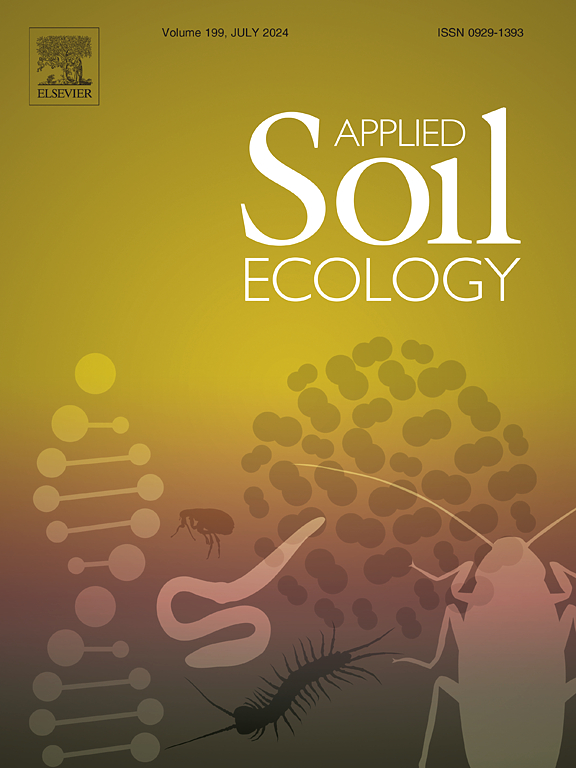秸秆还田配合节水灌溉通过调节稻田微生物群落结构改善土壤质量和水稻产量
IF 5
2区 农林科学
Q1 SOIL SCIENCE
引用次数: 0
摘要
虽然节水灌溉是可持续水稻生产的一种很有前途的水管理做法,但其对稻田土壤健康的影响仍然存在争议。秸秆还田为节水灌溉稻田保持土壤健康和提高水稻产量提供了宝贵的自然解决方案。然而,节水灌溉条件下秸秆还田对土壤理化特性、水稻产量和土壤微生物群落的影响及其联系和机制尚不清楚。为了解决这些知识空白,进行了一项为期4年的试验,采用四种处理方法:控制灌溉(C);淹水灌溉(F);秸秆还田控制灌溉;秸秆还田淹水灌溉(FS)。利用高通量测序技术,探讨土壤微生物群落对灌溉和秸秆还田的响应机制,探讨微生物群落活动对土壤养分动态的影响。结果表明,与漫灌相比,控制灌溉显著降低了土壤真菌α-多样性,降低了细菌群落(变形菌门和放线菌门)的相对丰度,提高了细菌趋化性。而秸秆还田与节水灌溉相结合并不会导致单独节水灌溉的不良影响。不同灌溉制度下秸秆还田显著提高了土壤全氮(TN)和有机碳(SOC)含量,以CS处理增幅最大。CS处理提高了与碳氮循环相关的土壤微生物代谢途径,导致土壤养分水平和水稻产量最高。与其他处理相比,CS处理使水稻总氮增加2.72% ~ 9.88%,有机碳增加1.28% ~ 9.31%,产量增加7.47% ~ 36.94%。因此,控制灌溉与秸秆还田相结合是一种有利于土壤长期健康的节水增产水稻栽培方式。本研究促进了我们对不同水碳调节条件下稻田土壤微生物群落活性和微生物介导的土壤养分循环变化的认识,为节水灌溉稻田土壤健康和可持续耕作提供了有价值的理论见解。本文章由计算机程序翻译,如有差异,请以英文原文为准。
Straw return combined with water-saving irrigation improves soil quality and rice yield by regulating microbial community structure in paddy fields
While water-saving irrigation represents a promising water management practice for sustainable rice production, its impact on soil health in rice paddies remains controversial. Straw return offers a valuable natural solution for maintaining soil health and increasing rice yields in water-saving irrigated rice fields. However, it is unclear how returning straw under water-saving irrigation affects the physicochemical characteristics of the soil, rice yield, and soil microbial community, as well as the linkages and underlying mechanisms. To address these knowledge gaps, a 4-year experiment was conducted with four treatments: controlled irrigation (C); flooded irrigation (F); controlled irrigation with straw return (CS); and flooded irrigation with straw return (FS). High-throughput sequencing was used to explore the mechanisms by which soil microbial communities respond to irrigation and straw return, and to investigate the impact of microbial community activity on soil nutrient dynamics. The results showed that compared to flooded irrigation, controlled irrigation significantly reduced the α-diversity of soil fungi, decreased the relative abundance of bacterial communities (Proteobacteria and Actinobacteria), and increased bacterial chemotaxis. While combining straw return with water-saving irrigation does not lead to the adverse effects observed under water-saving irrigation alone. Straw return under different irrigation regimes significantly increased soil total nitrogen (TN) and soil organic carbon (SOC) content, with the greatest increase in the CS treatment. CS treatment enhanced soil microbial metabolic pathways related to the carbon and nitrogen cycle, leading to the highest soil nutrient levels and rice yield. Compared to other treatments, CS increased TN by 2.72 % to 9.88 %, SOC by 1.28 % to 9.31 %, and rice yield by 7.47 % to 36.94 %. Therefore, controlled irrigation combined with straw return represents a water-saving and yield-enhancing rice cultivation practice beneficial for long-term soil health. This study advances our understanding of soil microbial community activity and microbial-mediated changes in soil nutrient cycling under different water‑carbon regulation in rice paddies, providing valuable theoretical insights for maintaining soil health and sustainable cultivation in water-saving irrigated rice fields.
求助全文
通过发布文献求助,成功后即可免费获取论文全文。
去求助
来源期刊

Applied Soil Ecology
农林科学-土壤科学
CiteScore
9.70
自引率
4.20%
发文量
363
审稿时长
5.3 months
期刊介绍:
Applied Soil Ecology addresses the role of soil organisms and their interactions in relation to: sustainability and productivity, nutrient cycling and other soil processes, the maintenance of soil functions, the impact of human activities on soil ecosystems and bio(techno)logical control of soil-inhabiting pests, diseases and weeds.
 求助内容:
求助内容: 应助结果提醒方式:
应助结果提醒方式:


